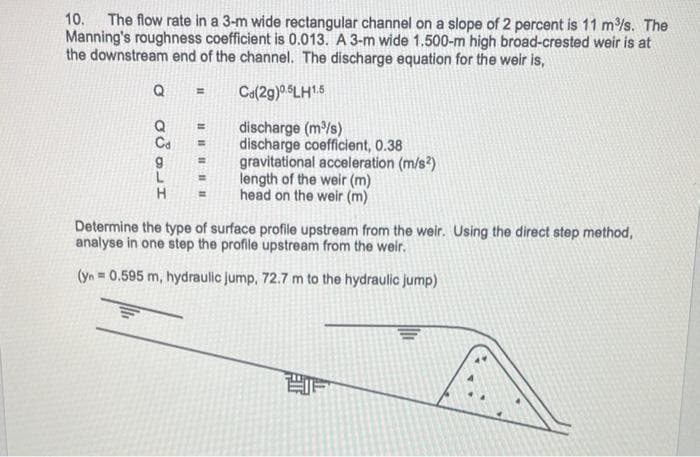The flow rate in a 3-m wide rectangular channel on a slope of 2 percent is 11 m/s. The Manning's roughness coefficient is 0.013. A 3-m wide 1.500-m high broad-crested weir is at the downstream end of the channel. The discharge equation for the weir is, 10. Q Ca(2g)5LH15 discharge (m/s) discharge coefficient, 0.38 gravitational acceleration (m/s?) length of the weir (m) head on the weir (m) %3! Ca %3D %3D L H %3! Determine the type of surface profile upstream from the weir. Using the direct step method, analyse in one step the profile upstream from the weir. (yn = 0.595 m, hydraulic jump, 72.7 m to the hydraulic jump) %3D
The flow rate in a 3-m wide rectangular channel on a slope of 2 percent is 11 m/s. The Manning's roughness coefficient is 0.013. A 3-m wide 1.500-m high broad-crested weir is at the downstream end of the channel. The discharge equation for the weir is, 10. Q Ca(2g)5LH15 discharge (m/s) discharge coefficient, 0.38 gravitational acceleration (m/s?) length of the weir (m) head on the weir (m) %3! Ca %3D %3D L H %3! Determine the type of surface profile upstream from the weir. Using the direct step method, analyse in one step the profile upstream from the weir. (yn = 0.595 m, hydraulic jump, 72.7 m to the hydraulic jump) %3D
Elements Of Electromagnetics
7th Edition
ISBN:9780190698614
Author:Sadiku, Matthew N. O.
Publisher:Sadiku, Matthew N. O.
ChapterMA: Math Assessment
Section: Chapter Questions
Problem 1.1MA
Related questions
Topic Video
Question

Transcribed Image Text:10. The flow rate in a 3-m wide rectangular channel on a slope of 2 percent is 11 m/s. The
Manning's roughness coefficient is 0.013. A 3-m wide 1.500-m high broad-crested weir is at
the downstream end of the channel. The discharge equation for the weir is,
Ca(2g)06LH15
%3D
discharge (m/s)
discharge coefficient, 0.38
gravitational acceleration (m/s?)
length of the weir (m)
head on the weir (m)
%3D
%3D
%3D
%3D
H.
Determine the type of surface profile upstream from the weir. Using the direct step method,
analyse in one step the profile upstream from the weir.
(yn = 0.595 m, hydraulic jump, 72.7 m to the hydraulic jump)
Expert Solution
This question has been solved!
Explore an expertly crafted, step-by-step solution for a thorough understanding of key concepts.
Step by step
Solved in 2 steps

Knowledge Booster
Learn more about
Need a deep-dive on the concept behind this application? Look no further. Learn more about this topic, mechanical-engineering and related others by exploring similar questions and additional content below.Recommended textbooks for you

Elements Of Electromagnetics
Mechanical Engineering
ISBN:
9780190698614
Author:
Sadiku, Matthew N. O.
Publisher:
Oxford University Press

Mechanics of Materials (10th Edition)
Mechanical Engineering
ISBN:
9780134319650
Author:
Russell C. Hibbeler
Publisher:
PEARSON

Thermodynamics: An Engineering Approach
Mechanical Engineering
ISBN:
9781259822674
Author:
Yunus A. Cengel Dr., Michael A. Boles
Publisher:
McGraw-Hill Education

Elements Of Electromagnetics
Mechanical Engineering
ISBN:
9780190698614
Author:
Sadiku, Matthew N. O.
Publisher:
Oxford University Press

Mechanics of Materials (10th Edition)
Mechanical Engineering
ISBN:
9780134319650
Author:
Russell C. Hibbeler
Publisher:
PEARSON

Thermodynamics: An Engineering Approach
Mechanical Engineering
ISBN:
9781259822674
Author:
Yunus A. Cengel Dr., Michael A. Boles
Publisher:
McGraw-Hill Education

Control Systems Engineering
Mechanical Engineering
ISBN:
9781118170519
Author:
Norman S. Nise
Publisher:
WILEY

Mechanics of Materials (MindTap Course List)
Mechanical Engineering
ISBN:
9781337093347
Author:
Barry J. Goodno, James M. Gere
Publisher:
Cengage Learning

Engineering Mechanics: Statics
Mechanical Engineering
ISBN:
9781118807330
Author:
James L. Meriam, L. G. Kraige, J. N. Bolton
Publisher:
WILEY